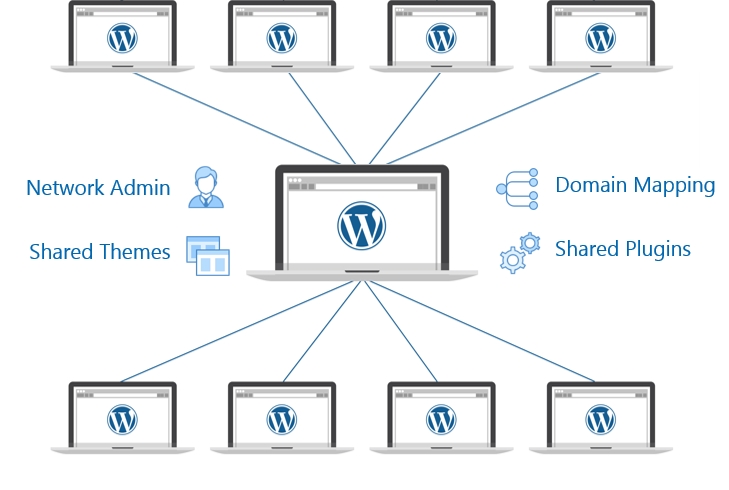Sometimes a web project requires room for growth. You might have a large amount of content which requires careful differentiation and organisation; a website which needs to serve a range of different customers or territories; or maybe a selection of brands which all need to co-exist whilst retaining their own identity.
There are a number of approaches to these sorts of problems but, increasingly, we find ourselves recommending a WordPress Multisite Network.
What is a WordPress Multisite Network?
At its core, a WordPress website is comprised of the codebase, which handles how the website looks and functions, and the database, which stores the content and other dynamic information.
A WordPress Multisite Network allows you to retain this basic structure — one codebase and one database — whilst serving a number of discrete websites. These could be subdirectories, e.g., ‘example.com/site1’ and ‘example.com/site2’, or subdomains, e.g., ‘site1.example.com’ and ‘site2.example.com’, or even entirely different domains, e.g., ‘example.com’ and ‘sample.com’.

Without beginning a new web project from scratch, you are able to leverage a large amount of flexibility and ultimately deliver multiple separate sites.
One of the key advantages of multiple websites sharing a codebase is that you can avoid unnecessary duplication of work.
For instance, a network of sites might all share a layout and very similar branding, with perhaps some minor colour or stylistic changes to set them apart. In this case, we can share the theme — i.e., the code which defines the layout and styling of a site — between the sites, and only make those small changes where you need to.
It’s worth bearing in mind that if two sites are different enough in style, layout or function, this benefit is essentially lost, but it’s a tool you can utilise when the right problem arises.
Advantages for Web Hosting
Another big benefit is the ability for a network of sites to share the same web host. Because the network is technically just a single codebase and database, it can all be stored in and accessed from the same place. When the network is suitable, this has the potential to cut down on administration and cost.
As before, this needs to be a considered choice. If a network of sites is expected to receive levels of traffic magnitudes of scale higher than a single site, the hosting must be properly equipped to handle this. Not all hosts can support a WordPress Multisite Network and it’s critical that your host’s hardware is ready for the requests and processing which will be asked of it.
There is also a major logistical upside to a WordPress Multisite Network. By default, each website within the network is treated as a discrete entity, complete with its own unique set of users and content. However, because the sites share a database, it is possible to allow users to access multiple sites and, in doing so, begin to mirror the hierarchical or workflow structure of larger, more complex organisations.
It might be that each site in a network represents a single department of one business and, on the front end, the user is not given the effect of switching to a totally new website. And in the back-end, key administrators can have the option to switch between and manage multiple sites without having to log in and out each time. This gives you more power and flexibility than might be possible with a standard, single-site installation of a content management system.
Considering your Project’s Requirements
It would be remiss of me not to mention that a WordPress Multisite Network is not the perfect solution every time. It’s critical to consider some of the limitations when making a decision about the optimal approach for a new project.
For example, if a server has downtime, all sites on that network will go down — something that might be avoided if they were all hosted separately. Similarly, if one site is hit by a large spike in traffic, this has the potential to affect the performance of all of the sites as the requests are hitting the same server and database.
So, like all of our tools, it is important to consider and recommend a WordPress Multisite Network when the application is proper. That said, we are experiencing a growing need for this type of solution for our clients and, in many cases, this type of network has been the ideal way to get multiple sites set up and operating more efficiently.
Have you tried using a WordPress Multisite Network to tackle the kinds of challenges explained above? Or have you tried other solutions? Tell us about your experiences below.
Alternatively, if you’d like to know more about our approach to these kinds of challenges then you can read about our Web Development service here.
